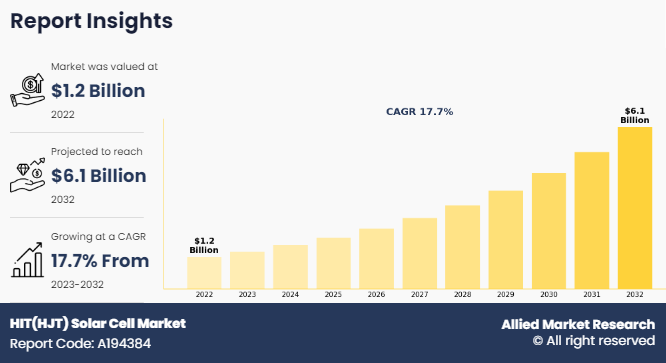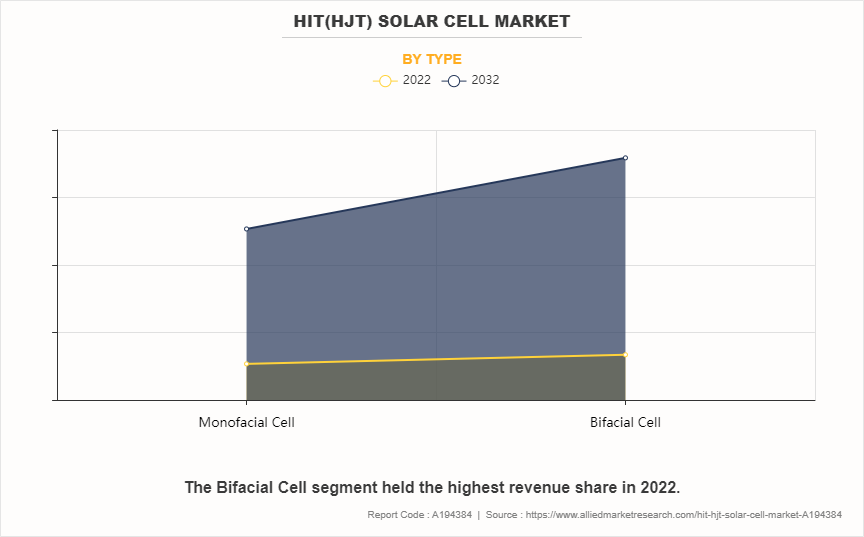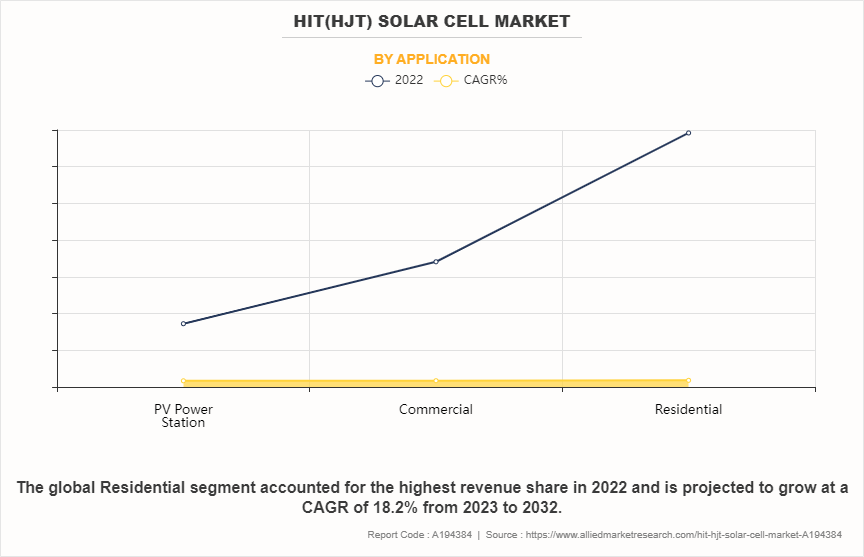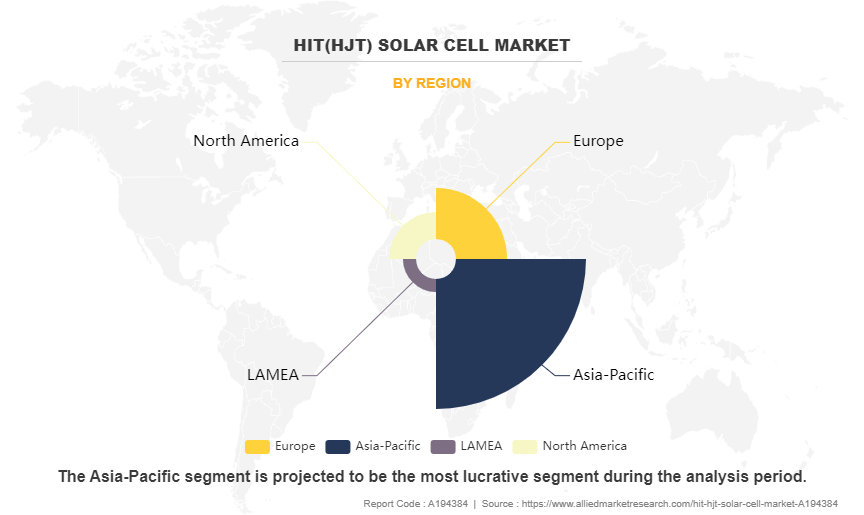HIT(HJT) Solar Cell Market Research, 2032
The global HIT (HJT) solar cell market was valued at $1.2 billion in 2022, and is projected to reach $6.1 billion by 2032, growing at a CAGR of 17.7% from 2023 to 2032.
A Heterojunction with Intrinsic Thin-layer (HIT) solar cell is a type of photovoltaic (PV) cell that combines multiple layers of different semiconductor materials to efficiently convert sunlight into electricity. The heterojunction design allows for more efficient charge carrier collection and reduced recombination losses compared to traditional solar cell designs. Therefore, HIT solar cells can achieve higher conversion efficiencies and better performance, particularly under low light conditions, compared to conventional crystalline silicon solar cells.

HIT (HJT) solar cell market boast high conversion efficiencies, often exceeding 22%, due to their unique structure combining crystalline silicon and thin-film technologies. As efficiency is a critical factor in solar energy production, the continual improvement of HIT (HJT) solar cell market efficiency has been a significant driver. HIT (HJT) solar cell market demonstrate better performance in high temperatures compared to conventional solar cells. This feature is particularly beneficial in regions with hot climates, where solar panels can be subjected to higher temperatures.
HIT (HJT) solar cell market have a lower temperature coefficient, which means their efficiency decreases in hot conditions compared to conventional silicon cells. This makes HIT (HJT) solar cell market more effective in maintaining higher performance levels during peak sunlight and summer months. HIT (HJT) solar cell market typically have a longer lifespan and better durability due to reduced degradation over time. This makes them a more attractive investment for both utility-scale and residential solar installations of heterojunction solar cell market.
Although the cost of solar technology has decreased over the years, the initial investment can still be significant for both manufacturers and consumers. High production costs can limit market penetration, especially in regions where traditional energy sources are relatively cheap. Solar cell manufacturing involves complex and precise processes, including doping, deposition, and patterning. These processes require specialized equipment and skilled labor, adding to production expenses.
The HIT (HJT) solar cell industry has experienced growth in recent years, leading to economies of scale in production. However, smaller manufacturers may still struggle to achieve cost competitiveness compared to larger, more established players. Regulatory requirements and policies can impact production costs, such as compliance with safety and environmental standards or tariffs on imported materials. Financing options like leasing, power purchase agreements (PPAs), or third-party ownership can make solar installations more affordable for consumers by spreading out the upfront costs over time.
As advancements in materials science and manufacturing processes progress, the production costs of HIT cells are expected to decrease. Lower production costs will make HIT technology more economically viable compared to traditional solar cell technologies, such as monocrystalline and polycrystalline silicon cells. The combination of improved efficiency and reduced production costs will enhance the competitiveness of HIT cells in the solar industry. This competitive advantage may lead to increased market share for HIT technology, particularly in regions where factors like high temperatures or low light conditions favor the performance of HIT (HJT) solar cell market.
Higher efficiency and lower costs will open up new opportunities for the deployment of HIT (HJT) solar cell market in various applications beyond traditional solar PV installations. These applications may include building-integrated photovoltaics (BIPV), portable solar chargers, solar-powered vehicles, and others. The increased adoption of HIT (HJT) solar cell market can contribute to significant environmental benefits by reducing greenhouse gas emissions associated with electricity generation. By harnessing solar energy more efficiently and cost-effectively, HIT technology can help mitigate climate change and promote a more sustainable energy future.
The key players profiled in this report include REC (India), GS-Solar (China), Jinergy (China), HuaSun (China), Akcome (China), TW Solar (Spain), Canadian Solar (Canada), Risen Energy (China), Enel (3SUN) (Italy), and Meyer Burger (Switzerland). Product innovation and development of HIT solar cell are common strategies followed by major market players. For instance, in November 2022, REC Group announced the production of the REC TwinPeak 5 Series, the fifth generation of its multiple-award-winning TwinPeak solar panels. The new product has improvised strength, including REC’s revolutionary Twin Design.
The HIT solar cell market is segmented on the basis of type, application, and region. By type, the market is classified into monofacial cell and bifacial cell. By application, the market is divided into PV power station, commercial, and residential. By region, the market is analyzed across North America, Europe, Asia-Pacific, and LAMEA.
The hit(hjt) solar cell market is segmented into Type and Application.

By type, the bifacial cell sub-segment dominated the global HIT solar cell market share in 2022. Bifacial cells offer higher efficiency compared to traditional monofacial cells. They can generate electricity from both sides by capturing sunlight from the front as well as reflected light from the rear, thereby increasing overall energy output. As the solar industry aims to reduce the cost of solar power generation, bifacial cells offer a cost-effective solution by maximizing energy production per unit area. This increased efficiency can help offset the higher initial cost of bifacial modules.
With increasing demand for solar energy and a growing emphasis on renewable sources, there is a parallel demand for higher performing solar panels. Bifacial cells, with their ability to capture more sunlight, meet this demand by offering improved performance compared to monofacial cells. Bifacial cells contribute to environmental sustainability by maximizing energy production without increasing land usage. They enable higher energy yields per unit area, which is crucial for achieving renewable energy targets while minimizing environmental impact.

By application, the residential sub-segment dominated the global HIT (HJT) solar cell market share in 2022. Due to increasing concerns about energy security and environmental sustainability, homeowners are increasingly interested in generating their own electricity. HIT solar cells offer a reliable and sustainable source of energy, enabling residential consumers to reduce their dependence on traditional energy sources and lower their carbon footprint. Government incentives such as tax credits, rebates, and net metering policies play a significant role in driving the adoption of solar technology in the residential segment. These incentives make HIT (HJT) solar cell market size installations more affordable for homeowners, encouraging them to invest in renewable energy solutions.
Increasing awareness regarding environmental issues and climate change prompts many homeowners to seek out sustainable energy solutions like HIT (HJT) solar cell market analysis. By choosing renewable energy sources, residential consumers can contribute to the reduction of greenhouse gas emissions and mitigate the impacts of climate change. As solar technology becomes more integrated into residential architecture, aesthetic considerations play a significant role in the choice of solar panels. HIT solar cells, with their sleek design and relatively high efficiency, appeal to homeowners who prioritize both performance and visual appeal.

By region, Asia-Pacific dominated the global HIT solar cell market in 2022. Asia-Pacific is experiencing rapid economic growth and urbanization, leading to an increasing demand for energy. Solar energy offers a sustainable and renewable solution to meet this rising demand, driving the adoption of solar cells in the region. The cost of solar photovoltaic (PV) technology has been decreasing steadily, making solar energy more competitive with traditional energy sources.
This cost reduction has been driven by advancements in technology, economies of scale, and manufacturing efficiencies, making solar cells more accessible to consumers and businesses in the region. Owing to increasing awareness regarding climate change and environmental degradation, there is a greater emphasis on transitioning to clean and renewable energy sources. Solar energy is environmentally friendly, emitting no greenhouse gases during operation, which aligns with the sustainability goals of many countries in Asia-Pacific.
Key Benefits For Stakeholders
- This report provides a quantitative analysis of the market segments, current trends, estimations, and dynamics of the HIT (HJT) solar cell market trends analysis from 2022 to 2032 to identify the prevailing hit(hjt) solar cell market opportunities.
- The HIT (HJT) solar cell market report research is offered along with information related to key drivers, restraints, and opportunities.
- Porter's five forces analysis highlights the potency of buyers and suppliers to enable stakeholders make profit-oriented business decisions and strengthen their supplier-buyer network.
- In-depth analysis of theHIT (HJT) solar cell market growth segmentation assists to determine the prevailing market opportunities.
- Major countries in each region are mapped according to their revenue contribution to the global HIT (HJT) solar cell market forecast.
- Market player positioning facilitates benchmarking and provides a clear understanding of the present position of the HIT (HJT) solar cell market news players.
- The report includes the analysis of the regional as well as global HIT (HJT) solar cell market overview trends, key players, market segments, application areas, and market growth strategies.
HIT(HJT) Solar Cell Market Report Highlights
| Aspects | Details |
| Market Size By 2032 | USD 6.1 billion |
| Growth Rate | CAGR of 17.7% |
| Forecast period | 2022 - 2032 |
| Report Pages | 310 |
| By Type |
|
| By Application |
|
| By Region |
|
| Key Market Players | REC (India), Canadian Solar, Meyer Burger, Jinergy, TW Solar, Akcome, HuaSun, akcome group, Risen Energy Co. Ltd., gs-solar, Enel (3SUN) |
Increasing awareness regarding environmental issues, such as climate change and air pollution, prompts individuals, businesses, and governments to shift towards clean and renewable energy sources like solar power. High-efficiency solar cells provide a way to generate more electricity with fewer resources and lower environmental impact, which is driving the market growth.
The major growth strategies adopted by the HIT solar cell market players are development of HIT solar cell and product innovation.
Asia-Pacific will provide more business opportunities for the global HIT solar cell market in the future.
REC (India), GS-Solar (China), Jinergy (China), HuaSun (China), Akcome (China), TW Solar (Spain), Canadian Solar (Canada), Risen Energy (China), Enel (3SUN) (Italy), and Meyer Burger (Switzerland) are the major players in the HIT solar cell market.
The residential sub-segment of the application segment acquired the maximum share of the global HIT solar cell market in 2022.
The commercial and industrial business sectors are the major customers in the global HIT solar cell market.
The report provides an extensive qualitative and quantitative analysis of the current trends and future estimations of the global HIT solar cell market from 2022 to 2032 to determine the prevailing opportunities.
HIT solar cells typically offer higher efficiency compared to traditional solar cells, making them attractive to residential users who want to maximize the energy output from their limited roof space. Rising awareness regarding climate change and environmental sustainability prompts many homeowners to seek clean energy solutions. HIT cells, with their efficient energy conversion and minimal environmental impact, align well with these concerns. These are the major factors expected to drive the adoption of HIT solar cell.
Solar energy reduces dependence on fossil fuels and mitigates the risks associated with fluctuating oil prices and geopolitical tensions. Countries seeking energy security are increasingly investing in solar power infrastructure, including high-efficiency solar cells. This ongoing trend is predicted to drive the global HIT solar cell market in the upcoming years.
Loading Table Of Content...
Loading Research Methodology...



